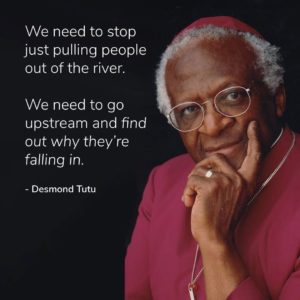(I originally posted this on LinkedIn last week, but wanted to share it here because I feel its relevance is applicable with a broader application.)
Are We Looking Far Enough Upstream?
 There is a great quote by Nobel Peace Prize recipient Archbishop Desmond Tutu that says, “There comes a point where we need to stop just pulling people out of the river. We need to go upstream and find out why they’re falling in.”
There is a great quote by Nobel Peace Prize recipient Archbishop Desmond Tutu that says, “There comes a point where we need to stop just pulling people out of the river. We need to go upstream and find out why they’re falling in.”
I see this shared now and then on social media relating to substance abuse, and it is absolutely applicable. The treatment field is continuing to scramble to meet demand, while also being hampered by in-fighting over what dollars are available to cover operational costs, especially since insurance carriers are continuing their assault on coverage and reimbursements However, I feel that even the most well-intended may fall short of going far enough up the stream.
It’s easy to associate this analogy with the rise in opioid-related fatalities, but many of the upstream solutions focus on prescribing habits and pharmaceutical industry corruption. To be clear, those do need to be dealt with as well, but we must go even further, as even when the supply of these drugs are limited there are other substances du jour that have to be tackled, which is a never-ending cycle in itself.
Prevention is a logical place to start, but how or what to prevent is the question. A lot of prevention is centered around the dryness of what drugs do to someone who takes them, and it simply misses the boat on social and behavioral realities of not just youth, but people of all ages. It also doesn’t give them solutions for handling life.
Substance use disorders often develop because the individual is seeking to find relief or solve a problem. Whether they are considered “self-medicating” or not is sometimes irrelevant, as many of the difficulties in life are still just symptoms of something else, as we have seen when people move in and out of various diagnoses throughout their lifetimes.
We have to build resiliency into the educational and familial systems early on. This can come in many ways, and one great place to start is with the concept of thought detachment – that we are not our thinking, and that thoughts can come and go without having to act on them. This increase in awareness allows for people to realize that they don’t have be the effect of their thinking, and that the physical sensations and feelings associated with the thoughts can also pass, as the water in the stream does, or the clouds in the sky.
Another way to build resilience is to focus on connection. It has been said that community is a foundation for recovery, and it’s a wonderful observation. Community – belonging and connection with a shared purpose – is also a way to build resiliency. The United States is among the worst in substance abuse rates in the world, whereas countries with cultures that are more community-focused have a lower incidence.
The same way that building resiliency helps in treatment for those with substance use disorders deal with trauma and other difficulties in life, it can help younger people deal with traumatic events more effectively early on, thus avoiding the desire to seek out relief through the use of drugs and alcohol. These traumatic events can vary widely, as well as each individual’s response to them. What may be somewhat trivial to some people can be devastating to others, and resiliency can help with all of it.
There are, of course, may other ways to increase one’s resiliency, and a great resource for that is the book Resilient: How to Grow an Unshakable Core of Calm, Strength, and Happiness by Rick Hanson, Ph.D. and Forrest Hanson.
I would hypothesize that the implementation of teaching resiliency from toddlers through college and beyond would do more for reduction of and relief from substance abuse and related behavioral health disorders than any other single action. I implore you to take a deep dive into this topic and see for yourself.